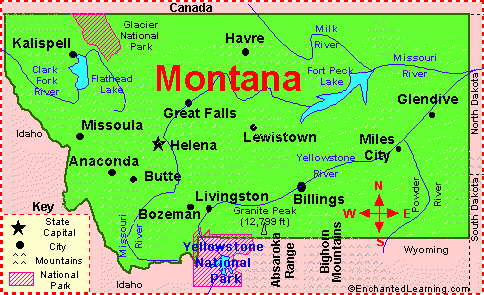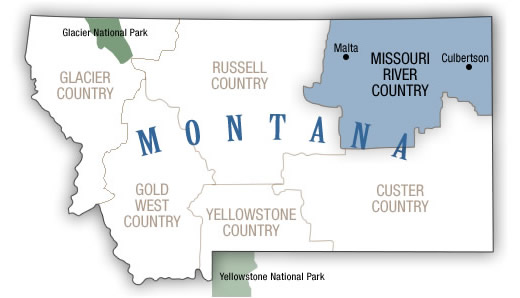As early as 12,000 years ago, prehistoric Paleo-Indians arrived in the Missouri River basin. Prominent Native American tribes that lived on the river in immediate pre-Columbian times included the Mandan, Sioux, Hidatsa, Osage, and Missouria – the latter for whom the river is named. After the 17th century, European and American explorers began to wander the region, and the Missouri basin became part of France's Louisiana; when the United States acquired the territory, the Lewis and Clark Expedition traveled the river partly in search of the mythical Northwest Passage. Later in the 19th century, the westward movement of American pioneers pushed Native Americans out of their traditional lands, leading to wars. The Missouri defined the American frontier in the 19th century, and many prominent westward routes, the Oregon Trail among them, followed the river and its tributaries.
Once, the Missouri River was by far the longest river of North America; today however, the Missouri's length is comparable to that of the Mississippi. This is due, in large part, to many of the Missouri River's meanders being cut to facilitate navigation. The lower Missouri valley has become a highly productive agricultural and industrial region, and barges shipping grown and manufactured products provide most of today's river commerce. In the 20th century, federal and state agencies including the U.S. Army Corps of Engineers (USACE) heavily dammed and channelized the river. Although all of this development has contributed to the region's economic growth, it has taken a toll on the ecology and the water quality of the Missouri.
Flowing eastwards through the plains of eastern Montana, the Missouri receives the Poplar River from the north before crossing into North Dakota where the Yellowstone River, its greatest tributary by volume, joins from the right. At the confluence, the Yellowstone is actually the larger river.[n 1] The Missouri then meanders east past Williston and into Lake Sakakawea, a reservoir formed by the Garrison Dam, where the river turns south. South of Riverdale, the Knife River enters from the right. The Missouri continues south to Bismarck, the capital of North Dakota, where it receives the Heart River. It slows into the Lake Oahe reservoir just before the Cannonball River confluence. While it continues south, eventually reaching Oahe Dam in South Dakota, the Grand, Moreau and Cheyenne Rivers all join the Missouri from the right.
With a drainage basin spanning 529,350 square miles (1,371,000 km2), the Missouri's catchment encompasses nearly one-sixth of the area of the United States or just over five percent of the continent of North America. The mostly flat, arid basin, comparable to the size of the Canadian province of Quebec, encompasses most of the northern Great Plains, stretching over 1,500 miles (2,400 km) from the Rocky Mountains in the west to the Mississippi River valley in the east. From north to south it reaches well over 1,600 miles (2,600 km), from the southern extreme of western Canada in the north to the Arkansas River valley of the south. Compared with the Mississippi River above their confluence, the Missouri is actually much longer (150%) and drains a far greater area (309%). However, the flow of the Missouri at the confluence accounts for only 45 percent of the total amount of water below the meeting of the rivers.

Montana\x26#39;s Missouri River Map

Major Rivers - Yellowstone

Montana River Map

Montana Map W Direction sWeb

Missouri River-Musselshell

Missouri River map

Upper Missouri River Fold-out

Missouri river, Montana,

Missouri River Map

Montana Map

Montana\x26#39;s Best Road Trip

along the Missouri River

Montana\x26#39;s Best Road Trip

Missouri River Montana Map

refuge map

Montana\x26#39;s Missouri River
Once, the Missouri River was by far the longest river of North America; today however, the Missouri's length is comparable to that of the Mississippi. This is due, in large part, to many of the Missouri River's meanders being cut to facilitate navigation. The lower Missouri valley has become a highly productive agricultural and industrial region, and barges shipping grown and manufactured products provide most of today's river commerce. In the 20th century, federal and state agencies including the U.S. Army Corps of Engineers (USACE) heavily dammed and channelized the river. Although all of this development has contributed to the region's economic growth, it has taken a toll on the ecology and the water quality of the Missouri.
Flowing eastwards through the plains of eastern Montana, the Missouri receives the Poplar River from the north before crossing into North Dakota where the Yellowstone River, its greatest tributary by volume, joins from the right. At the confluence, the Yellowstone is actually the larger river.[n 1] The Missouri then meanders east past Williston and into Lake Sakakawea, a reservoir formed by the Garrison Dam, where the river turns south. South of Riverdale, the Knife River enters from the right. The Missouri continues south to Bismarck, the capital of North Dakota, where it receives the Heart River. It slows into the Lake Oahe reservoir just before the Cannonball River confluence. While it continues south, eventually reaching Oahe Dam in South Dakota, the Grand, Moreau and Cheyenne Rivers all join the Missouri from the right.
With a drainage basin spanning 529,350 square miles (1,371,000 km2), the Missouri's catchment encompasses nearly one-sixth of the area of the United States or just over five percent of the continent of North America. The mostly flat, arid basin, comparable to the size of the Canadian province of Quebec, encompasses most of the northern Great Plains, stretching over 1,500 miles (2,400 km) from the Rocky Mountains in the west to the Mississippi River valley in the east. From north to south it reaches well over 1,600 miles (2,600 km), from the southern extreme of western Canada in the north to the Arkansas River valley of the south. Compared with the Mississippi River above their confluence, the Missouri is actually much longer (150%) and drains a far greater area (309%). However, the flow of the Missouri at the confluence accounts for only 45 percent of the total amount of water below the meeting of the rivers.

Montana\x26#39;s Missouri River Map
Major Rivers - Yellowstone

Montana River Map

Montana Map W Direction sWeb

Missouri River-Musselshell

Missouri River map

Upper Missouri River Fold-out

Missouri river, Montana,

Missouri River Map

Montana Map

Montana\x26#39;s Best Road Trip

along the Missouri River

Montana\x26#39;s Best Road Trip

Missouri River Montana Map

refuge map

Montana\x26#39;s Missouri River
No comments:
Post a Comment